Australia: Chronic Kidney Disease, Public Health Analysis Report
VerifiedAdded on 2019/12/18
|5
|885
|198
Report
AI Summary
This report examines the public health impact of chronic kidney disease (CKD) in Australia. It begins by outlining the prevalence of CKD in the Australian population, with a specific comparison between indigenous and non-indigenous populations, highlighting disparities in incidence rates. The report then delves into the burden of the disease, utilizing metrics such as DALY (Disability-Adjusted Life Years) and YLL (Years of Life Lost) to quantify the impact on the Australian population. Furthermore, the report outlines relevant health policies and strategies that have been developed to address the challenges posed by CKD in Australia, including national frameworks and government initiatives. The report concludes with a list of cited references. This report provides a detailed overview of CKD's impact on Australia's public health landscape.
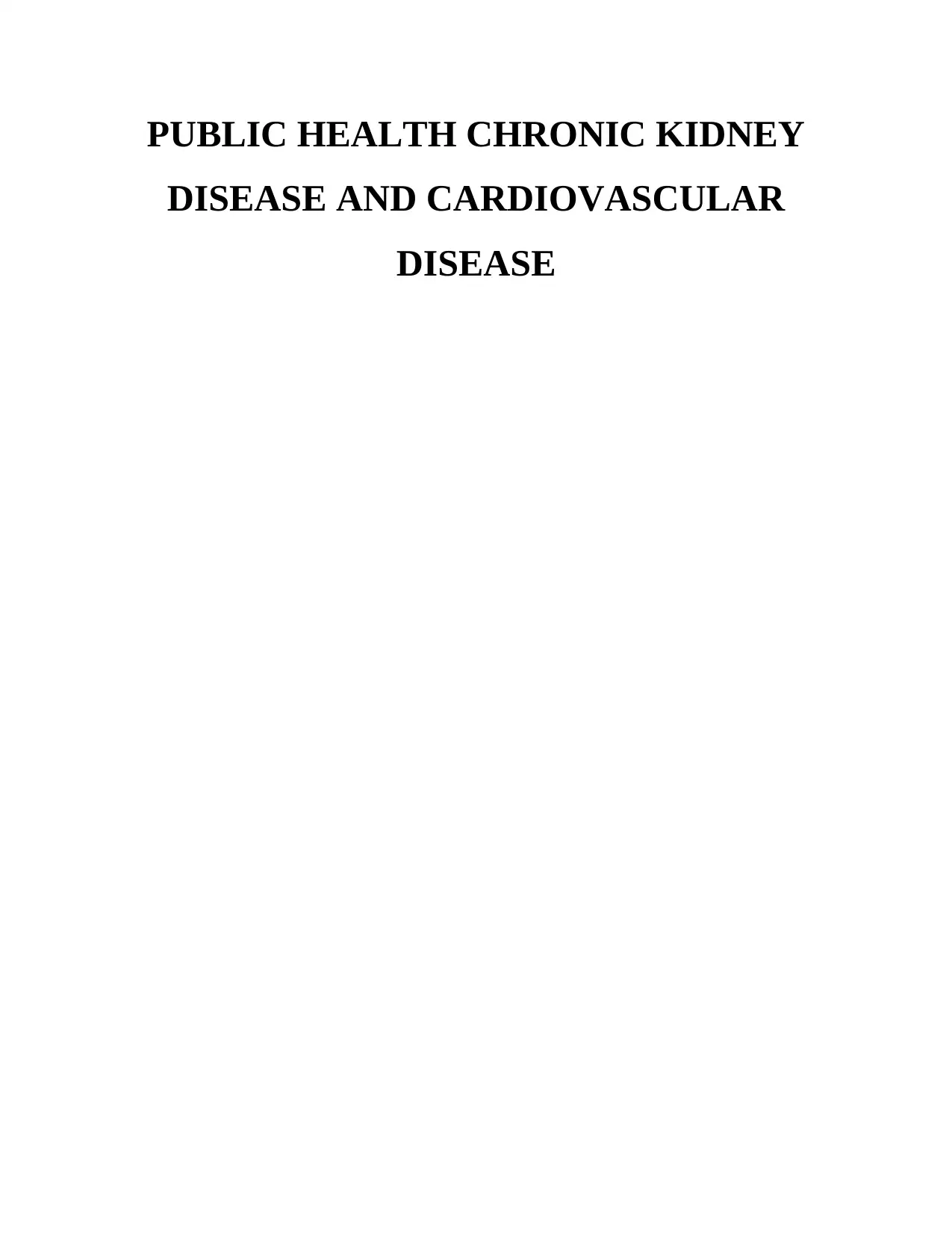
PUBLIC HEALTH CHRONIC KIDNEY
DISEASE AND CARDIOVASCULAR
DISEASE
DISEASE AND CARDIOVASCULAR
DISEASE
Paraphrase This Document
Need a fresh take? Get an instant paraphrase of this document with our AI Paraphraser
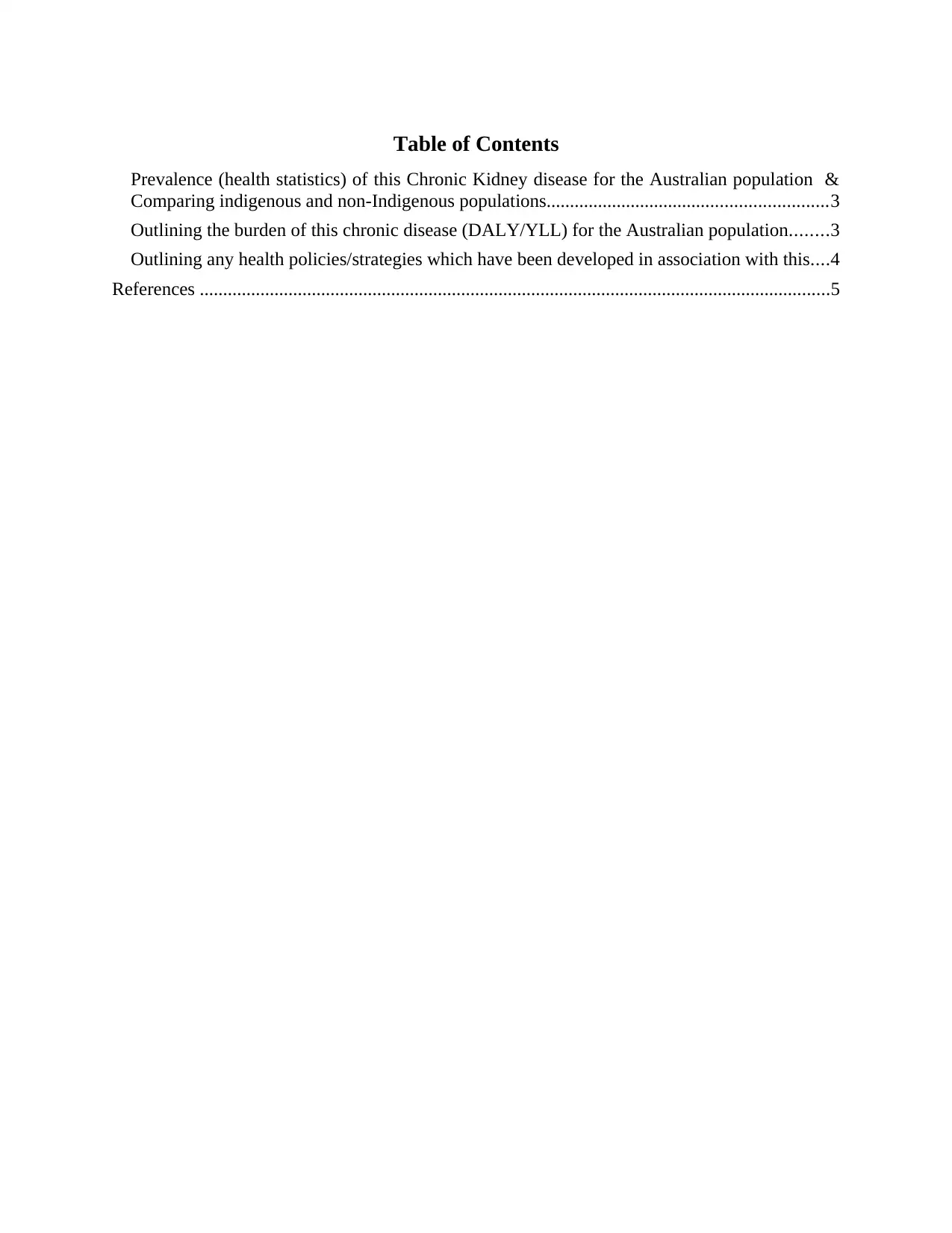
Table of Contents
Prevalence (health statistics) of this Chronic Kidney disease for the Australian population &
Comparing indigenous and non-Indigenous populations............................................................3
Outlining the burden of this chronic disease (DALY/YLL) for the Australian population........3
Outlining any health policies/strategies which have been developed in association with this....4
References .......................................................................................................................................5
Prevalence (health statistics) of this Chronic Kidney disease for the Australian population &
Comparing indigenous and non-Indigenous populations............................................................3
Outlining the burden of this chronic disease (DALY/YLL) for the Australian population........3
Outlining any health policies/strategies which have been developed in association with this....4
References .......................................................................................................................................5
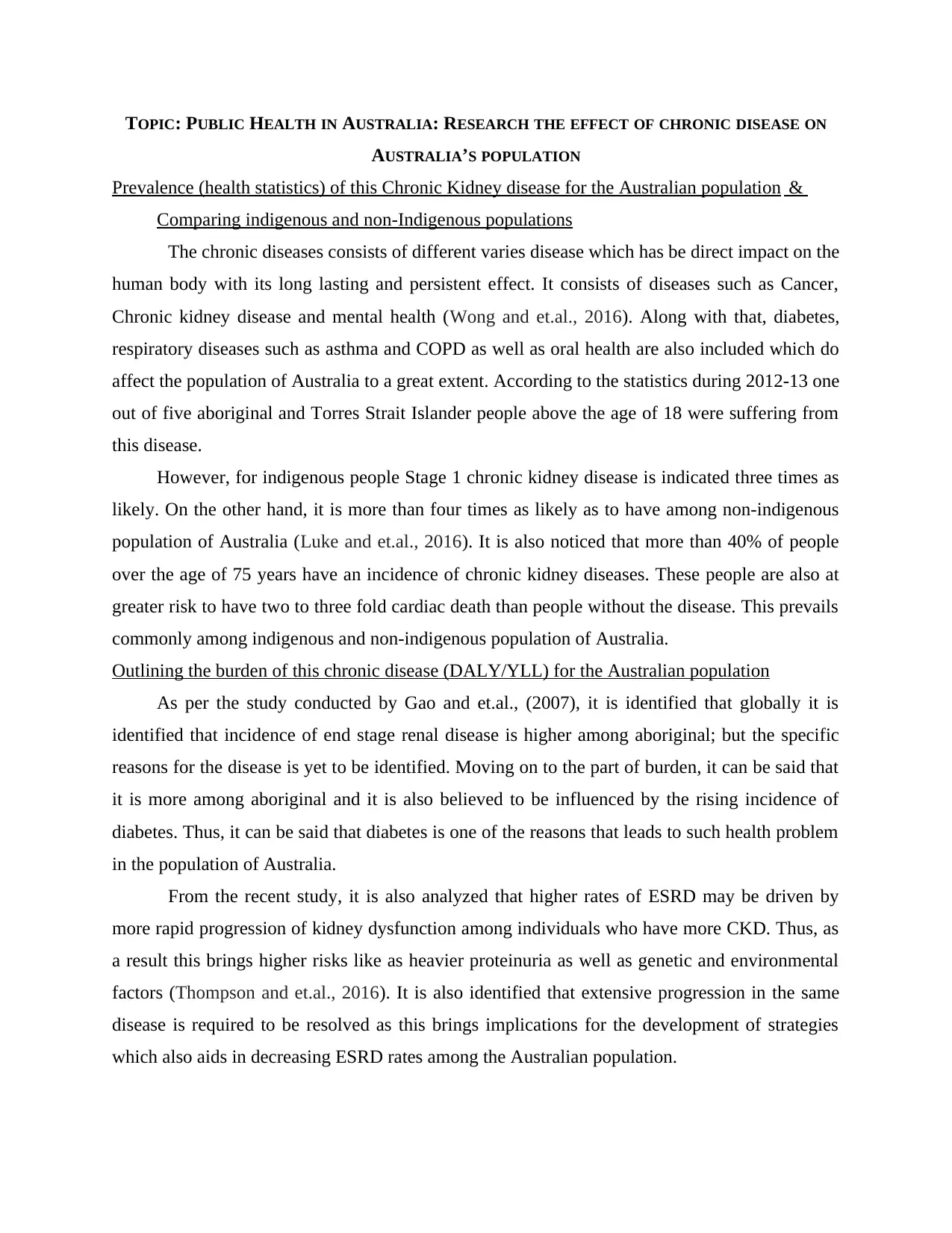
TOPIC: PUBLIC HEALTH IN AUSTRALIA: RESEARCH THE EFFECT OF CHRONIC DISEASE ON
AUSTRALIA’S POPULATION
Prevalence (health statistics) of this Chronic Kidney disease for the Australian population &
Comparing indigenous and non-Indigenous populations
The chronic diseases consists of different varies disease which has be direct impact on the
human body with its long lasting and persistent effect. It consists of diseases such as Cancer,
Chronic kidney disease and mental health (Wong and et.al., 2016). Along with that, diabetes,
respiratory diseases such as asthma and COPD as well as oral health are also included which do
affect the population of Australia to a great extent. According to the statistics during 2012-13 one
out of five aboriginal and Torres Strait Islander people above the age of 18 were suffering from
this disease.
However, for indigenous people Stage 1 chronic kidney disease is indicated three times as
likely. On the other hand, it is more than four times as likely as to have among non-indigenous
population of Australia (Luke and et.al., 2016). It is also noticed that more than 40% of people
over the age of 75 years have an incidence of chronic kidney diseases. These people are also at
greater risk to have two to three fold cardiac death than people without the disease. This prevails
commonly among indigenous and non-indigenous population of Australia.
Outlining the burden of this chronic disease (DALY/YLL) for the Australian population
As per the study conducted by Gao and et.al., (2007), it is identified that globally it is
identified that incidence of end stage renal disease is higher among aboriginal; but the specific
reasons for the disease is yet to be identified. Moving on to the part of burden, it can be said that
it is more among aboriginal and it is also believed to be influenced by the rising incidence of
diabetes. Thus, it can be said that diabetes is one of the reasons that leads to such health problem
in the population of Australia.
From the recent study, it is also analyzed that higher rates of ESRD may be driven by
more rapid progression of kidney dysfunction among individuals who have more CKD. Thus, as
a result this brings higher risks like as heavier proteinuria as well as genetic and environmental
factors (Thompson and et.al., 2016). It is also identified that extensive progression in the same
disease is required to be resolved as this brings implications for the development of strategies
which also aids in decreasing ESRD rates among the Australian population.
AUSTRALIA’S POPULATION
Prevalence (health statistics) of this Chronic Kidney disease for the Australian population &
Comparing indigenous and non-Indigenous populations
The chronic diseases consists of different varies disease which has be direct impact on the
human body with its long lasting and persistent effect. It consists of diseases such as Cancer,
Chronic kidney disease and mental health (Wong and et.al., 2016). Along with that, diabetes,
respiratory diseases such as asthma and COPD as well as oral health are also included which do
affect the population of Australia to a great extent. According to the statistics during 2012-13 one
out of five aboriginal and Torres Strait Islander people above the age of 18 were suffering from
this disease.
However, for indigenous people Stage 1 chronic kidney disease is indicated three times as
likely. On the other hand, it is more than four times as likely as to have among non-indigenous
population of Australia (Luke and et.al., 2016). It is also noticed that more than 40% of people
over the age of 75 years have an incidence of chronic kidney diseases. These people are also at
greater risk to have two to three fold cardiac death than people without the disease. This prevails
commonly among indigenous and non-indigenous population of Australia.
Outlining the burden of this chronic disease (DALY/YLL) for the Australian population
As per the study conducted by Gao and et.al., (2007), it is identified that globally it is
identified that incidence of end stage renal disease is higher among aboriginal; but the specific
reasons for the disease is yet to be identified. Moving on to the part of burden, it can be said that
it is more among aboriginal and it is also believed to be influenced by the rising incidence of
diabetes. Thus, it can be said that diabetes is one of the reasons that leads to such health problem
in the population of Australia.
From the recent study, it is also analyzed that higher rates of ESRD may be driven by
more rapid progression of kidney dysfunction among individuals who have more CKD. Thus, as
a result this brings higher risks like as heavier proteinuria as well as genetic and environmental
factors (Thompson and et.al., 2016). It is also identified that extensive progression in the same
disease is required to be resolved as this brings implications for the development of strategies
which also aids in decreasing ESRD rates among the Australian population.
⊘ This is a preview!⊘
Do you want full access?
Subscribe today to unlock all pages.

Trusted by 1+ million students worldwide
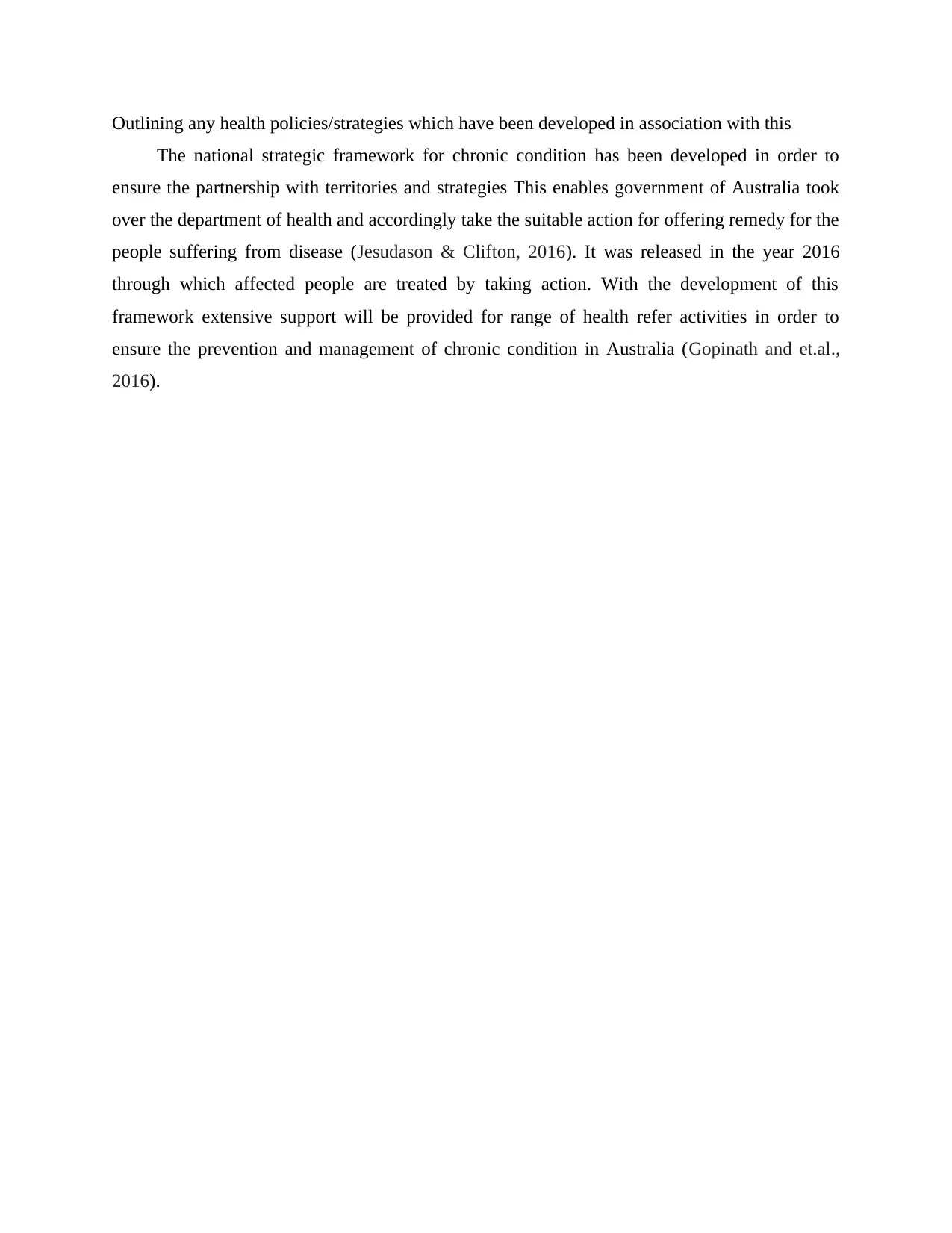
Outlining any health policies/strategies which have been developed in association with this
The national strategic framework for chronic condition has been developed in order to
ensure the partnership with territories and strategies This enables government of Australia took
over the department of health and accordingly take the suitable action for offering remedy for the
people suffering from disease (Jesudason & Clifton, 2016). It was released in the year 2016
through which affected people are treated by taking action. With the development of this
framework extensive support will be provided for range of health refer activities in order to
ensure the prevention and management of chronic condition in Australia (Gopinath and et.al.,
2016).
The national strategic framework for chronic condition has been developed in order to
ensure the partnership with territories and strategies This enables government of Australia took
over the department of health and accordingly take the suitable action for offering remedy for the
people suffering from disease (Jesudason & Clifton, 2016). It was released in the year 2016
through which affected people are treated by taking action. With the development of this
framework extensive support will be provided for range of health refer activities in order to
ensure the prevention and management of chronic condition in Australia (Gopinath and et.al.,
2016).
Paraphrase This Document
Need a fresh take? Get an instant paraphrase of this document with our AI Paraphraser
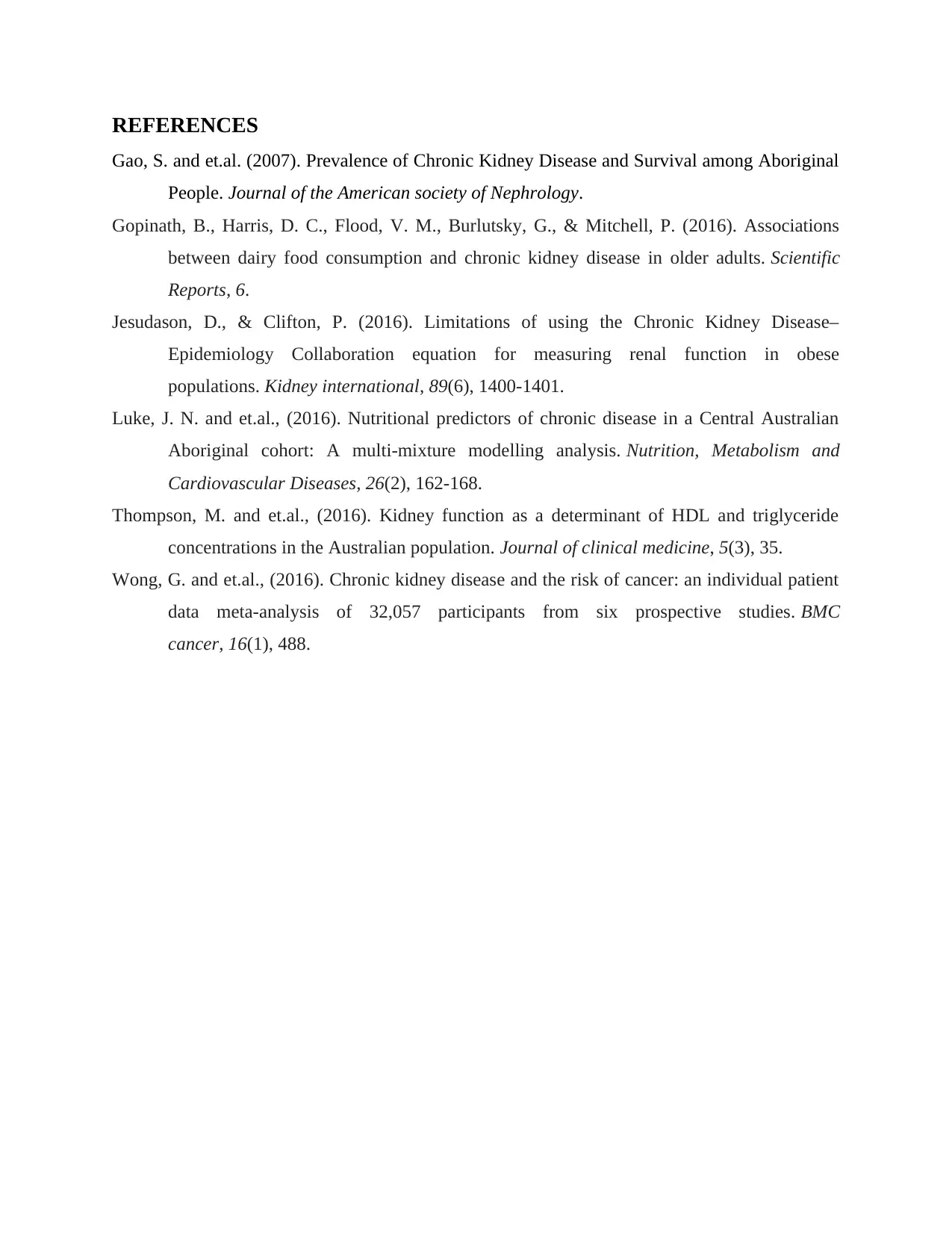
REFERENCES
Gao, S. and et.al. (2007). Prevalence of Chronic Kidney Disease and Survival among Aboriginal
People. Journal of the American society of Nephrology.
Gopinath, B., Harris, D. C., Flood, V. M., Burlutsky, G., & Mitchell, P. (2016). Associations
between dairy food consumption and chronic kidney disease in older adults. Scientific
Reports, 6.
Jesudason, D., & Clifton, P. (2016). Limitations of using the Chronic Kidney Disease–
Epidemiology Collaboration equation for measuring renal function in obese
populations. Kidney international, 89(6), 1400-1401.
Luke, J. N. and et.al., (2016). Nutritional predictors of chronic disease in a Central Australian
Aboriginal cohort: A multi-mixture modelling analysis. Nutrition, Metabolism and
Cardiovascular Diseases, 26(2), 162-168.
Thompson, M. and et.al., (2016). Kidney function as a determinant of HDL and triglyceride
concentrations in the Australian population. Journal of clinical medicine, 5(3), 35.
Wong, G. and et.al., (2016). Chronic kidney disease and the risk of cancer: an individual patient
data meta-analysis of 32,057 participants from six prospective studies. BMC
cancer, 16(1), 488.
Gao, S. and et.al. (2007). Prevalence of Chronic Kidney Disease and Survival among Aboriginal
People. Journal of the American society of Nephrology.
Gopinath, B., Harris, D. C., Flood, V. M., Burlutsky, G., & Mitchell, P. (2016). Associations
between dairy food consumption and chronic kidney disease in older adults. Scientific
Reports, 6.
Jesudason, D., & Clifton, P. (2016). Limitations of using the Chronic Kidney Disease–
Epidemiology Collaboration equation for measuring renal function in obese
populations. Kidney international, 89(6), 1400-1401.
Luke, J. N. and et.al., (2016). Nutritional predictors of chronic disease in a Central Australian
Aboriginal cohort: A multi-mixture modelling analysis. Nutrition, Metabolism and
Cardiovascular Diseases, 26(2), 162-168.
Thompson, M. and et.al., (2016). Kidney function as a determinant of HDL and triglyceride
concentrations in the Australian population. Journal of clinical medicine, 5(3), 35.
Wong, G. and et.al., (2016). Chronic kidney disease and the risk of cancer: an individual patient
data meta-analysis of 32,057 participants from six prospective studies. BMC
cancer, 16(1), 488.
1 out of 5
Related Documents
Your All-in-One AI-Powered Toolkit for Academic Success.
+13062052269
info@desklib.com
Available 24*7 on WhatsApp / Email
![[object Object]](/_next/static/media/star-bottom.7253800d.svg)
Unlock your academic potential
Copyright © 2020–2025 A2Z Services. All Rights Reserved. Developed and managed by ZUCOL.




